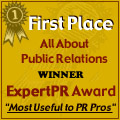|
by
Roni
M. Singleton
Dittus Communications
Usually
public relations professionals
have two goals in mind when
leveraging media and PR for a
client: Raise the client's
visibility and enhance the
client's business goals. But how
does even the most out-of-the-box
thinker make old news sexy? Or
does a PR person simply continue
to churn out press releases about
a once hot topic, like technology
whose industry is waning? 
When your company doesn't have
anything newsworthy to report,
don't waste time pulling together
an expensive press conference
about nothing. Instead here
are some suggestions on how to use
your time and your client's wallet
more effectively and efficiently.
Think more strategically, and try
some of the techniques below.
Rethink
press releases:
Drafting and getting press
releases approved can be
extremely time consuming. Too
often they end up on a Web site
(a potential black hole) where
media may never see it unless
they are already familiar with
your company. Instead why not
prepare a brief bio of your
client or company with a list of
"hot topics" the CEO
or a manager can discuss.
Send these out to producers and
reporters with a short note
asking to add your expert to
their Rolodex.
Op-eds/articles: If
your clients have expertise on a
specific subject, try drafting
an op-ed for them, or encourage
them to write an article
targeted to their audience.
Perhaps an editor would be
interested in featuring a
regular column from your client.
Speaking opportunities:
Look for upcoming
seminars/conferences for the
target audience of your client
company. Draft speaker proposals
and submit them to conference
organizers that might benefit
from your client's expertise.
Roundtable discussions:
Suggest that your company
initiate a roundtable or teach a
one-day seminar -- perhaps for
free -- providing valuable
information to potential and
current clients. It's a
great way for your client to
garner some new business and for
you to reap event publicity!
Online media: Research
and develop lists of online
mainstream publications such as The
New York Times and USA
Today, and also popular
sites read by target business
audiences.
Desk-side visits: Yes,
there are a still a few
journalists who have time to
meet with you or someone within
your organization --
particularly if your company can
offer information for a story
the reporter is currently
working on. Find a handful
of key journalists that cover
your industry regularly and who
you would like to get to know
you better. This is an
effective way to build
credibility and get your
organization quoted.
Host regular lunches for
reporters: These
lunches are designed to
introduce a specific reporter to
a company, and they give you an
opportunity to present some
current and upcoming activities
or products.
Third-party opportunities: Read,
Read, Read. Make sure you
are aware of what's happening in
the news everyday. If you
do not have access to a
television in your office,
bookmark news sites relevant to
your organization. If you
represent a company that can
discuss airline safety after two
planes nearly collide at a major
airport, make sure all of the
major dailies and networks have
a backgrounder on your guy.
Community work: An easy
way to gain quick exposure is to
provide a community service.
Such work is often quite "promotable"
and allows your company to be
known as a good corporate
citizen among peer companies.
Think pro bono.
Take
advantage of the days when your
company doesn't have news to
report, and flex your creative
muscle. Use some of the
techniques above to create media
opportunities that will warrant
ink, even when your news day is
slow.
Roni
M. Singleton is a director in the
Marketing Communications
department at Dittus
Communications, one of
Washington's
leading marketing and
public affairs firms.
Article
republished with permission from
PR FUEL,
a weekly PR tips
E-newsletter at eReleases.com
More
Articles | Submit
Your Article | PR
Subjects
About
Public Relations Homepage
Contact Us
|

